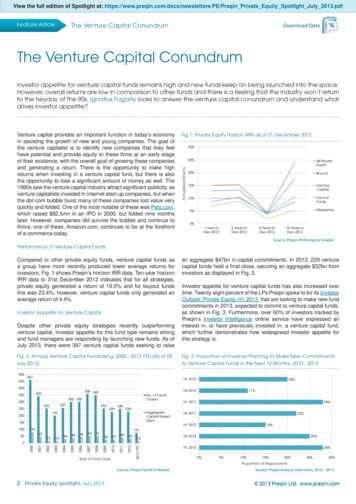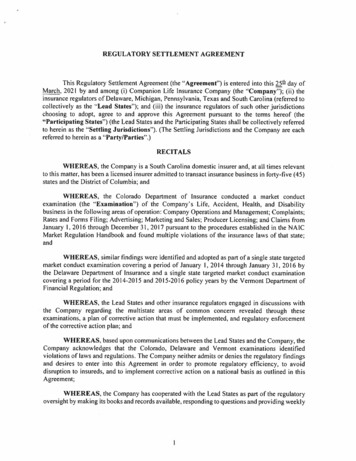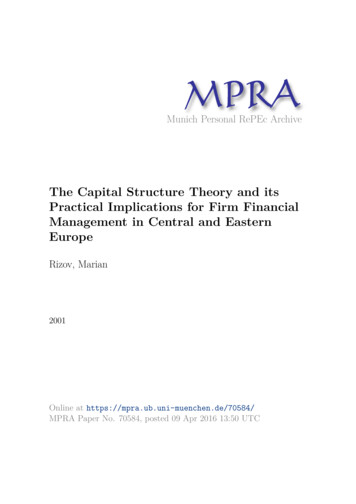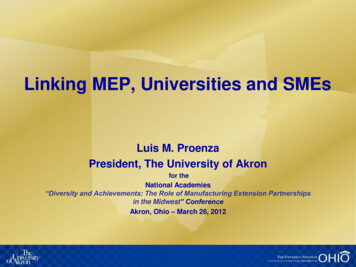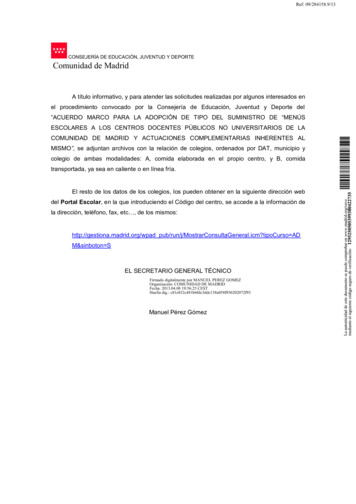
Transcription
Capital Plans and Needs of Health CentersA National PerspectivePrepared by Capital Link Summer 2014 2014 Capital LinkCapital Plans and Needs of Health Centers i
ACKNOWLEDGEMENTThis publication was supported by Grant/Cooperative Agreement Number U30CS09741 from the HealthResources and Services Administration, Bureau of Primary Health Care (HRSA/BPHC). The contentsof this publication are solely the responsibility of the author(s) and do not necessarily represent the officialviews of HRSA/BPHC.Capital Link, established in 1998, is a non-profit organization that has worked with hundreds ofhealth centers and primary care associations for over 15 years to plan capital projects, finance growth,and identify ways to improve performance. From market feasibility and program, staff, and facilityplans to comprehensive financing assistance, Capital Link provides innovative consulting services andextensive technical assistance with the goal of supporting and expanding community-based health care.Additionally, Capital Link works in partnership with primary care associations, the National Associationof Community Health Centers, and other entities interested in improving access to capital for healthcenters. For more information, visit www.caplink.org.ii Capital Plans and Needs of Health Centers 2014 Capital Link
IntroductionThe dramatic increase in community health center patients over the past several years has necessitatedrapid growth in health center facilities. Between 2005 and 2012, patients of Section 330 health centers1grew 50% from 14.1 to 21.1 million requiring a 12.5 billion increase in health center property, plant,equipment, and leased space to accommodate the nearly 25,000 providers who serve them. Continuedexpeditious investment in fixed assets (both owned and leased) will be necessary to enable healthcenters to grow to serve the 35 million patients expected as a result of the Affordable Care Act’s (ACA)implementation.Capital Link conducted a national capital needs assessment of community health centers in the fall of2013 to determine their capital project plans, investment needs, sources of capital, projected fundinggaps, and growth readiness to expand facilities to meet the projected overall market need. The researchindicates planned capital projects would provide capacity to serve 30 million patients annually by 2018,but considerable uncertainty exists regarding whether the necessary funding and other needed assistancewill be available to support the desired growth. Furthermore, this level of facility investment will not besufficient to accommodate the number of patients projected to be served by health centers between FY1618. Key findings and implications from the assessment are described below.Community Health Center Capital Project Plans and Funding Needs 2014-2018Health center capital needs data was solicited from the approximately 1,200 Federally Qualified HealthCenters (FQHCs)2 nationally and collected from 398 health centers in all 50 states, DC, and Puerto Rico,representing a response rate of 33%.Three-fourths of the responding health centers reported plans to initiate one or more projects over the nextfive years to replace, renovate, or improve current facilities and/or to expand existing capacity. The projectedcost of the capital development is 1.7 billion. Extrapolating that figure to the national universe of 1,200health centers, Capital Link estimates planned capital investments for all health centers of 5.1 billion overthe next five years for owned facilities and 2.6 billion for leased space.The facilities investment, if implemented and funded, would allow health centers to accommodate anadditional 5.9 million patients for a total capacity of 30 million patients and 31,000 providers in 2018.With 32 million patients projected, however, a total capital investment of 10.3 billion in physicalinfrastructure, including leased space of 3.4 billion, will be needed to meet demand.Section 330 of the Public Health Service Act is the authorizing legislation for the Health Center Program. Section 330 healthcenters receive grants under the Health Center Program and are also sometimes referred to as “federally-funded health centers”or “grantees.”2A federally qualified health center (FQHC) is a type of provider defined by the Medicare and Medicaid statutes. FQHCsinclude all organizations receiving grants under Section 330 of the Public Health Service Act, certain tribal organizations, andFQHC Look-Alikes.1 2014 Capital LinkCapital Plans and Needs of Health Centers 1
For health center-owned projects, respondents have identified and secured funding for only 37% of thecost of planned projects. Extrapolating to the full universe of health centers nationally, total secured capitaldevelopment funding is likely at most 2.1 billion, leaving a funding gap of 3 billion to accommodatepatient growth needs in health center-owned facilities. To reach the 32 million patient goal, a funding gapof at least 4.8 billion likely exists for owned facilities.The table below summarizes the national community health center project plans and funding needs.Community Health Center Capital Project Plans and Funding Needs 2014-2018398 National FQHCRespondents1,200 NationalFQHCs PlannedProjects1,200 NationalFQHCs NeededGrowthAdditional Projected Patient Capacity2 Million5.9 Million7.9 MillionTotal Projected Patient Capacity26 Million30 Million32 MillionProjected Capital Project Costs(Including Leased Facilities) 2.6 Billion 7.7 Billion 10.3 BillionProjected Capital ProjectCosts (Owned Only) 1.7 Billion 5.1 Billion 6.9 BillionFunding Gap (Cost Less SecuredFunding for Owned Only) 1.1 Billion 3 Billion 4.8 BillionSquare Footage to be Built, Renovated,or Expanded (Owned Only)4.8 Million14.4 Million19.3 MillionCapital Project Plans:Responding health centers reported plans to initiate 528 capital projects which, when extrapolated to thefull grantee list, equates to over 1,500 projects nationally.The following table shows that of the estimated 5.1 billion in spending for health center owned capitalprojects, the majority of funding required ( 4.1 billion or 80%) is for actual construction costs—whetherfor new construction, renovation or expansion of space. Construction costs represented 84% of projectedspending in Capital Link’s 2012 national capital needs assessment. Equipment expenses comprise another11% of total funds needed—slightly more than 8% in the last assessment, while the 5% allocated forrefinancing existing debt in the latest study is considerably more than the 1% figure included in the priorone.2 Capital Plans and Needs of Health Centers 2014 Capital Link
Components of Planned Capital ProjectsRespondent CapitalPlans by ComponentPercent ofTotal CostExtrapolated All CHCCapital Plans 2013-2018Construction/Hard Costs 688 Million80% 4.1 BillionEquipment Purchase 91 Million11% 541 MillionRefinance Existing Facilities 41 Million5% 246 MillionLeasehold Improvements 29 Million3% 172 MillionHIT or EMR Purchase 14 Million2% 82 MillionPurchase Land/Building 1 Million0% 6 Million 863 Million100% 5.1 BillionProject ComponentTotal Project SizeThe breakdown of planned capital projects by type is highlighted in the accompanying chart. The proposedconstruction of additional or replacement sites, at 57% of all planned projects, outpaces the plannedexpansion or renovation of existing buildings, which comprise 40% of projected capital plans. HealthInformation Technology (HIT) and Electronic Medical Records (EMR) system investments represent only3% of planned projects.Type of Capital Project PlannedThe average project size, estimated at 3.2 million in thisassessment, is less than the 3.8 million figure forecast in theExisting Siteassessment completed in 2012. The change is not surprisingAdditional/Replacement Sitegiven that most of the larger capital grants are expected to beHIT/EMRdone by the end of 2015.HIT/EMR3%Projected Funding Sources:27Existing SiteAdditional/Replacement SiteOf the 1.7 billion in projects identified by the sample group,HIT/EMR37% of funding ( 625 million), or a total of 2.1 billion whenextrapolated to the full universe of health centers, was reportedas secured. Over 1 billion, or almost 50% of that funding, isexpected to come from a combination of state grants, equity,and fundraising. Conversely, only 8% ( 175 million) of securedfunding is identified as federal or other grant support. Detailsare provided in the Projected Secured Funding Sources table onthe following page. 2014 Capital LinkReplacementSiteReplacSitExpandExisting Site27%20%RenovateExisting SiteAdditional Site20%30%Capital Plans and Needs of Health Centers 3
Projected Secured Funding SourcesSample HealthCenters MillionsExtrapolatedto All HealthCenters Millions% of TotalSecured FundingState Grant 143.8 480.723%Equity 89.2 298.214%Fundraising or Contributions 69.8 233.211%Other Loan (Bank, etc.) 67.5 225.711%Tax-Exempt Bond 56.8 189.89%Federal Grants 52.4 175.18%USDA Loan Guaranteed 46.2 154.57%New Markets or other Tax Credit Program 44.9 150.07%USDA Community Facilities Direct Loan 28.0 93.74%HRSA Loan Guaranteed 26.3 87.84%Total Secured Funding 625.1 2.1 Billion100%Funding Source (Secured)In Millions 50%The relatively small amount of funding projected from federal/other grants represents the most significantchange from the prior assessment. In the 2012 study, health centers reported 40% of all secured fundingwas from federal sources, largely driven by the 2 billion in HRSA capital grants made available throughthe American Recovery and Reinvestment Act (ARRA) and the Affordable Care Act (ACA)3 between2009 and when the 2012 assessment was completed. The precipitous decline in federal capital grant supportcould have a significant negative impact on health centers’ ability to complete capital projects if they areunable to successfully access a different mix of funding sources, including state grants, equity (i.e. healthcenter cash reserves), fundraising, and contributions. Given the challenges facing state budgets, healthcenters’ abilities to secure significant funds from states may be more limited than hoped. In addition, thefact that resources available through the HRSA Loan Guarantee Program have largely been expendedpoints to the need for alternative funding sources to fill this gap as well.The importance of tax-exempt bonds as an increasingly larger proportion of health center capital projectfunding should also be noted. While tax-exempt bonds comprised 1% of secured funding in the priorstudy, that figure has jumped to 9% in the recent assessment. The table on the following page provides acomparison of secured funding sources for the current assessment vs. the prior one, highlighting that totalgrant equity sources now comprise 17% less of overall secured funding.3A total of 3 billion in HRSA capital grants were authorized as part of ARRA and the ACA.4 Capital Plans and Needs of Health Centers 2014 Capital Link
13%Secured Funding Sources FY14 Assessment vs. FY1223%14%Funding Source (Secured)14%2012 Study6%State GrantEquityFundraising or Contributions1%Federal GrantsOther Loan (Bank, etc.)1%1%Tax Exempt Bond1%USDA Loan GuaranteedNew Markets or other Tax Credit ProgramUSDA Community Facilities Direct LoanHRSA Loan GuaranteedTotal Secured FundingChangeFrom Prior2014 Study13%11%23%10%13%14%14%11% 14%23%0%6%14%9%11% 14%6%14%11%8% 11%40%-32%14%-3%7%9%11%6%9%7%8%40%8%40%6%6%7%4% 7%1%3% 6%4% 7%1%3%2%4%4%2%100%2%100%4%Growth in Capital Investments in Facilities:From FY05 through FY12, health centers investedapproximately 8.5 billion in their physical infrastructure,with approximately 3.2 billion (37%) coming from debtsources and 5.3 billion (63%) from grants or health centerequity. In addition, leased capital assets increased by almost 4 billion.Notably, about 37% ( 2 billion of the 5.3 billion) of theequity increase between FY05 and FY12 resulted fromone-time HRSA capital grant awards. Therefore, achievingcomparable levels of equity investment in the coming periodmay be challenging. Health centers may need to rely moreheavily on debt to finance their projects and will also needto seek private sector grants through capital campaigns,foundations, and other charitable sources. 2014 Capital Link-16%5%1%3%8%4% 7%1%2%Grant/EquitySources of Fixed Asset/Property,Plant & Equipment Growth 12.5 4 10.3 3.4Leased SpaceEquityDebt 5.3 4.2 3.2 2.7Total Raised FY05-FY12(7 Years)Needed Capital ProjectsFY14-FY18 (5 years)Capital Plans and Needs of Health Centers 5Debt16%
Growth in Health Center Property, Plant & Equipment:The following chart illustrates the increases in gross fixed assets as well as the annual incremental changesin debt and equity between FY05 and FY12. The significant increases in FY10-FY12 clearly reflect theimpact of the HRSA capital grants that were awarded during this period.Health Center Investment in Facilities & EquipmentOwned Only, FY05-FY12Incremental Change in Debt During Year15Incremental Change in Equity During Year13.3Gross Fixed Assets at End of Year1311.8119.19Billions of 10FY11FY12Growth in Health Center Facilities, Including Leased Property:Capital Link’s research indicates health centers own approximately two-thirds of their facility space andlease the other third. Assuming the ratio is the same going forward and that the costs of constructing orrenovating leased space is similar to that of owned space, the following chart shows the estimated totalinvestment in health center-occupied space for FY05-FY18 under two scenarios.The baseline forecast shows a 29 billion overall investment in gross fixed assets, including leased property,by FY18 based on the 5.1 investment in planned health center-owned projects. As noted on the chart,that level of investment would increase capacity to serve 28-30 million patients annually over the nextseveral years. However, the estimated patient need, also presented on the chart, is expected to rise to 30-32million over the period, assuming the maintenance of currently-authorized levels of health center federaloperating support through FY16 with modest increases thereafter.The chart clearly shows that absent a greater investment in physical capacity than currently planned byhealth centers, they will likely not have the space to accommodate the level of patients expected beginningin FY16. A minimum additional investment in health center facilities totaling 2.6 billion, including leasedspace, would be necessary between FY15 and FY18 to accommodate the additional two million patients6 Capital Plans and Needs of Health Centers 2014 Capital Link
expected. The more aggressive capital investment projection shows a need for a 32 billion investment inhealth center occupied space by 2018 - an increase of 10.3 billion over FY14 levels.Health Center Projected Patient Capacity Needsand Facility InvestmentsEstimated Actual Investment in Fixed Assets2 million gap in capacity toserve projected patientsAdditional Fixed Asset Investment Needed to Meet Projected Patient Targets 9040Estimated Fixed Asset Investments Based on Current Health Center PlansActual Patients as Reported to HRSA (UDS) 70Projected Patients Assuming Budgeted 330 Grant LevelsEstimated Actual Patient Capacity30Estimated Patient Capacity Based on Health Center Plans 6021Billions of Dollars 50 40 301614171815192025262821223529302526232017 30 31 3215 26 18 20 1024323026191916222331 9 12 8 11 7FY05FY06FY07FY08FY09 20 21 22Millions of Patients 8010 145 -0FY10FY11FY12FY13FY14FY15FY16FY17FY18Note: Estimated total gross Fixed Assets includes Leased Assets and are based on Estimated Patients. Dashes indicate projected amounts.Health centers must also continue to invest in existing facilities especially considering that more than 25%of health center buildings are over 30 years old.4 In fact, of the responding health centers, 35% said someof their locations (aside from those already discussed in the capital projects section) require maintenanceor upgrades in the near future for their continued use. Any capital investments health centers make inmaintaining current facilities could squeeze out investment in new sites or expanded facilitates, thusinhibiting their overall ability to grow.Co-Location, Collaboration, and Merger Plans:Approximately 40% of planned projects involved co-location or collaborations, most often with schools,other human service providers, housing, and health departments. These partnerships could offer interestingpotential funding or financing options through working with foundations, Community DevelopmentFinancial Institutions (CDFIs), or others interested in supporting particular industries or programs.In addition, 12% of respondents are contemplating mergers or acquisitions with other health centers ororganizations. Any such consolidations could have implications for capital funding and working capitalneeds, which health centers must plan for and address.4Capital Link, Capital Plans and Needs of Health Centers: A National Perspective (2012), 11. 2014 Capital LinkCapital Plans and Needs of Health Centers 7
Growth Capital Requirements:Health center growth and/or significant practice model changes often result in liquidity challenges thatrequire financing support. Twenty-eight percent of the study’s respondents anticipate a need for suchgrowth capital in the next five years above and beyond their current lines of credit. As outlined in thefollowing chart, 16% of health centers anticipate a funding need associated with implementing the PatientCentered Medical Home (PCMH) model of care and 15% expect losses when starting a new site.Nine percent of responding health centers listed a need for growth capital to integrate behavioral healthservices, while 8% of respondents required assistance to participate in Accountable Care Organizations(ACOs). Interestingly, only 5% of all respondents anticipated a need for financing assistance to cover thelosses involved in transitioning to a new payment system and only 2% projected a need associated withElectronic Health Record implementation.Respondents Expressing a Need for Growth Capital% of respondents whoanswered yesCover costs associated with implementing PCMH model of care16%Cover losses during start-up of a new site15%Integration of Behavioral Health9%Develop/participate in Accountable Care Organization (ACO)8%Acquire/merge with another organization6%Create sufficient reserves for risk-based contracting5%Cover losses associated with transitioning to new payment system5%Cover losses associated with EHR implementation2%Total Respondents Expressing Any Need for Growth Capital28%Growth Readiness:Significant planning, market analysis, and financial assessments are necessary before initiating capitalprojects. Most of the responding health centers had completed some planning processes necessary forfacility growth, particularly in the analysis of patient visits and capacity and market needs as outlined inthe following table.8 Capital Plans and Needs of Health Centers 2014 Capital Link
Capital Development Pre-Planning ProcessesConducted by Health CenterPercentAnalysis of Patient Visits65%Needs/Market Assessment59%Analysis of Patient Capacity54%Community Outreach52%Analysis of Debt Capacity38%Note: total exceeds 100% due to multiple responses.A number of planning activities related to specific capital projects have also been completed, predominantlyspace planning and site selection as summarized below. However, additional work involving financialprojections, business plans, architectural design, site control, and financing options analyses will need to becompleted for projects to move forward in a timely fashion.Planning Activities Conductedfor Specific Capital ProjectsPercentSpace Plan/Room Requirements52%Site Selection43%Financial Projections37%Architectural Design33%Business Plan Development29%Site Control19%Financing Options Analyses17%Capital Campaign Feasiblity Analysis13%Note: total exceeds 100% due to multiple responses.Challenges to Capital Development Growth:Respondents rated the building of equity and securing grant funding—essential ingredients for successfulcapital projects—as their main challenges to growth. They also listed limited staff time to work on capitalprojects and the need for more fundraising as other main challenges. Their summary responses areincluded in the following table. 2014 Capital LinkCapital Plans and Needs of Health Centers 9
Main Challenges to Meeting Capital NeedsPercentBuilding Equity/Cash Reserves46%Securing Grant Funding44%Staff Time to Work on Project38%Fundraising38%Fluctuations in Cash Flow23%Securing Loan Funding21%Payer Mix19%Note: total exceeds 100% due to multiple responses.In addition to the challenges of securing funding and allocating sufficient staff time to work on capitalexpansion, health centers must also recognize that projects are often more expensive and take longer toplan and build than anticipated.ConclusionIn summary, this study offers the following insights, which may be useful to health centers, policy-makers,and funders as they consider challenges associated with health center growth:1. Health centers are planning to undertake capital projects totaling 5.1 billion for which the fundinggap is 3 billion. Raising sufficient capital to accomplish the planned growth will be extremelychallenging particularly since federal grant funding will be less available.2. Even if those projects can be fully-funded and built, the additional capacity will not be sufficient toaccommodate the number of patients anticipated to arise from the ACA. A capital investment of 6.9 billion for health center-owned facilities, of which 4.8 billion is not yet secured, is needed. Anadditional leased facility investment of 3.4 billion, or a total investment of 10.3 billion, is required tobuild capacity to serve the patient growth target of 32 million by 2018.3. Health centers are beginning to look beyond traditional brick and mortar financing needs to securecapital required to support growth. They are also increasingly considering collaborations and colocations to provide expansion opportunities.4. Aggressive growth plans necessitate careful planning to ensure successful projects and ongoing healthcenter viability. Investing time and effort in planning for expansion will pay off in the long-term.10 Capital Plans and Needs of Health Centers 2014 Capital Link
Appendix ARespondent Profile:An analysis was undertaken to ensure thehealth center sample included in the study hadkey characteristics (rural vs. urban location,geographical region, and operating budget size)that were consistent with the entire universe of2012 UDS health center grantees.The charts on the following page indicate thedistribution of respondents is representative of theuniverse of health centers generally, noting thefollowing differences: The sample had a slightly lower percentageof rural health centers and a slightly higherproportion of urban health centers than thegrantee universe. See charts to the right.Respondents vs. All Grantees by Location:Urban vs. RuralAll rce: HRSA 2012 UDS FQHC List Each HRSA Region was well-represented in the sample although the sample had a higher percentageof participants than the proportion of grantees for some regions, notably Regions 1, 9, and 10. Likewise,for Regions 3, 4, and 6, the proportion of participants was lower in the sample than in the full universe.In all others, which includes Regions 2, 5, 7, and 8, the proportion of participants was very similar tothe proportion of grantees. Note that HRSA Regions are defined on page 13 of this report. Larger health centers, defined as those with an operating budget size of 10 million of more, had arelatively stronger representation in the sample while smaller health centers responded at a lower rate.This is not surprising since larger health centers are generally more active in the building and financingof capital projects. 2014 Capital LinkCapital Plans and Needs of Health Centers 11
Respondents vs. All Grantees by RegionRegion 1Region 2Region 3Region 4Region 5Region 6Region 7Region 8Region 9Region 100%5%10%15%ALL FQHC20%25%RespondentsRespondents vs. All Grantees by Operating Budget Sizeless than 1.0 1.0 to 2.9 3.0 to 4.9 5.0 to 9.9 10.0 to 19.9 20.0 to 49.9 50.0 to 74.9 75.0 to 99.9more than 100.00%5%10%15%ALL FQHC12 Capital Plans and Needs of Health Centers20%25%30%35%Respondents 2014 Capital Link
Methodology:Online capital needs assessments were sent in the fall of 2013 via e-mail to the CEOs, COOs, and CFOsof approximately 1,200 HRSA grantees and Look-Alikes. Health centers received three notifications andreminders to participate. The availability of the national capital needs assessment was publicized in CapitalLink’s newsletter, website, PCA, and NACHC websites where possible, and through other channels toensure all health centers were aware of the project and invited to participate. All PCAs and NACHCwere personally contacted to encourage their member centers to respond. Additional follow-up e-mailswere sent and access to a shorter assessment was provided to those states with low participation to ensure arepresentative national sample of capital needs information was collected. These methods netted 296 directhealth center responses.Internal Capital Link documents and the organization’s financial database were reviewed for additionalcompleted, current, and potential projects to determine status and outstanding capital needs. For healthcenters that had listed projects or capital needs in Capital Link’s last capital needs assessment and/or forthose that received Capital Development-Building Capacity (CD-BC) grants from HRSA, progress onthose projects was reviewed where information was publicly available to determine remaining fundinggap, and, as needed, centers were contacted to determine their current project status and funding gap. Onehundred and two unique health center responses were collected in this manner.When incomplete project data was provided or available, Capital Link project staff contacted individualhealth centers and/or estimated project costs and funding gaps. Capital Link’s project cost report was usedto estimate building costs by state and internal guidelines and industry standards were used for squarefootage needed based on projected staff and/or full-time equivalent employee additions5.HRSA Grantee Regions:Region 1: Connecticut, Maine, Massachusetts, New Hampshire, Rhode Island, and VermontRegion 2: New Jersey, New York, Puerto Rico, and the Virgin IslandsRegion 3: Delaware, District of Columbia, Maryland, Pennsylvania, Virginia, and West VirginiaRegion 4: Alabama, Florida, Georgia, Kentucky, Mississippi, North Carolina, South Carolina, andTennesseeRegion 5: Illinois, Indiana, Michigan, Minnesota, Ohio, and WisconsinRegion 6: Arkansas, Louisiana, New Mexico, Oklahoma, and TexasRegion 7: Iowa, Kansas, Missouri, and NebraskaRegion 8: Colorado, Montana, North Dakota, South Dakota, Utah, and WyomingRegion 9: Arizona, California, Hawaii, Nevada, American Samoa, Commonwealth of the NorthernMariana Islands, Federated States of Micronesia, Guam, Marshall Islands, and Republic of PalauRegion 10: Alaska, Idaho, Oregon, and Washington5Capital Link, Estimating Capital Project Costs for Health Centers ( June, 2013), 7. 2014 Capital LinkCapital Plans and Needs of Health Centers 13
The breakdown of planned capital projects by type is highlighted in the accompanying chart. The proposed construction of additional or replacement sites, at 57% of all planned projects, outpaces the planned expansion or renovation of existing buildings, which comprise 40% of projected capital plans. Health
